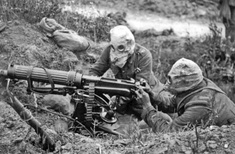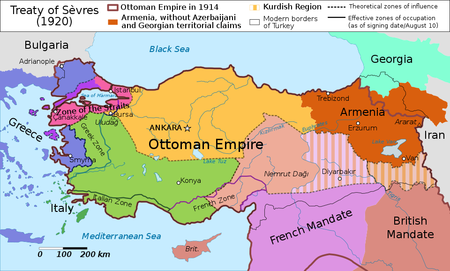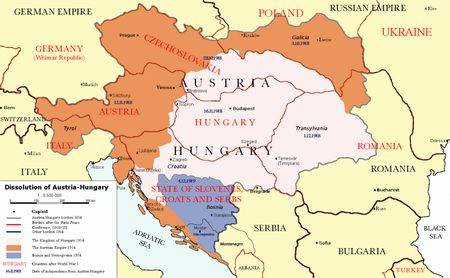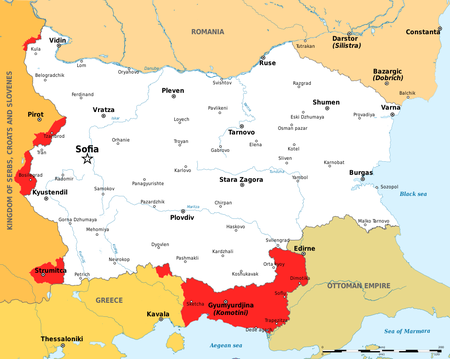
World War I and treaties explained (20th Century Explained #1)
Last updated: Wednesday April 21st, 2021
Report this blog
The 20th Century
In this series, I explore events that happened during the 20th century. I will be exploring topics ranging from the World Wars to the Cold War, from the Great Depression to the Fall of communism. This is the first of this series. This is about World War I and the treaties signed during the Paris Peace Conference (1919-1920).
World War I
The lead-up of WWI started after the Franco-Prussian War, between France and the North German Confederation. After defeating the French, Prussia was allowed to unite with the southern German states, creating the German Empire, which seized land and made France pay money to them. This war left the two sides as enemies. To protect itself from future invasion, France looked for allies. It quickly found allies of the UK and Russia, creating the Triple Entente. Germany also sought allies and found Austria-Hungary, and Italy, although it was technically a defense pact. Europe was about to explode. All it needed was a spark. And that spark happened on June 28, 1914. That day, Archduke Franz Ferdinand and his wife were traveling to Sarajevo, in modern-day Bosnia, ignoring warnings from the Serbian government not to go. 19-year-old Nedeljko Čabrinović threw a grenade at the royal couple as they passed. Luckily for them, the bomb bounced off and exploded on another officers’ car. But while returning to Vienna, 20-year-old Gavrilo Princip shot at the royal couple. The archduchess died almost immediately, while the archduke died in the hospital. One month later, Austria sent an ultimatum to Serbia. Austria-Hungary declared war on Serbia after Serbia in World War One had started. Almost immediately, Germany and Russia entered the war (on opposite sides), and France helped out on the side of Russia. The UK was showing interest in the war, but to Germany, that would be a huge blow, as they would need to fight the Royal Navy. Fortunately for Germany, the UK didn’t join. Well, not until Germany invaded neutral Belgium, that is. The United States opted to stay out of the war, with President Wilson saying that the United States should stay “neutral in fact as well as in name.” However, some people favored one side better than the other depending on their origin country. So by the time September came around, this is how it looked:
| Allied (Entente) Powers | Central Powers |
|---|---|
| Serbia | Austria-Hungary |
| Russia | Germany |
| France | |
| Belgium | |
| UK and Commonwealth |
Of course, many countries joined this war. For the Allies (Entente), their best friends were Italy and Japan. Italy had a defense pact with Austria-Hungary and Germany, but since Austria-Hungary declared war on Serbia and not the other way around, they stayed neutral. They joined the Allies after promises of more land. Japan was making an empire and was happy to annex German colonies in Asia and the Pacific. The Central Powers’ new friends were a 600-year-old empire in the middle east: the Ottoman Empire. There was trench warfare, when two sides fought each other in trenches, losing thousands of lives just to gain little land. There were poisonous gases that both sides used. And there were great sea battles, air battles, and one of the bloodiest battles of the century: Verdun. The Germans had been stockpiling weapons near the city, and on February 21, 1916, the bloodiest battle of the war began. The French were able to hold off the Germans, but it came at the high cost of 500,000 men on both sides. To distract the Germans, the British opened a battle at the Somme River. Once again, stalemate. The British, however, did invent the tank. Cool. However, the Germans were doing something that was not so cool. They bombed civilian cities and sank ships. One of the most famous was the Lusitania. The Lusitania was a passenger ship sailing from NYC to Liverpool. It was struck and sunk by a German torpedo. However, the allies had been hiding anti-submarine weapons in the cargo, which let Germany not get into any big trouble. The Germans came to a deal that they would stop sinking civilian ships. But the real trigger was the Zimmerman telegram, named after Arthur Zimmermann. It asked Mexico to join the war on Germany’s side, and in return, they would get Texas and New Mexico back. There was one problem: the cable had to go through the UK before it could pass the Atlantic ocean. It was intercepted and decoded by the UK, who showed the United States, and they declared war. After Greece joined the war, the table now looked like this:
| Allied (Entente) Powers | Central Powers |
|---|---|
| Serbia | Austria-Hungary |
| Russia | Germany |
| France | Ottoman Empire |
| Belgium | Bulgaria |
| UK and Commonwealth | |
| Italy | |
| Japan | |
| Romania | |
| Portugal | |
| United States | |
| Greece | |
Russia was a rapidly declining country. Before WWI, it had lost to the Ottoman Empire and Japan. In 1917, Alexander Kerensky overthrew the monarchy and set up a democracy. However, they still didn’t pull out of the war. Vladamir Lenin, living in Switzerland, was then called by the Germans to overthrow the government and set up a government. He arrived in Petrograd, and after overthrowing the government, staying in WWI, getting invaded by Germany, surrendering, giving up territory, and winning a bloody civil war, he died. Russia had lost huge territories in Finland, Estonia, Latvia, as well as territory given to Poland and Romania. So, Germany had been lucky that Russia was out of the war. Unfortunately for them, they were losing the war. The Ottoman Empire and Bulgaria, and eventually Austria-Hungary, surrendered. And on the 11th hour of the 11th day of the 11th month, Germany surrendered, ending the war.
The Post-War Treaties
Germany and the Allied Powers signed the Treaty of Versailles on the fifth anniversary of the assassination at Sarajevo. The treaty officially ended the war, limited the German army, and gave lands to neighboring countries and the newly-created Poland. Japan annexed Germany’s Pacific colonies, and France, the UK, and South Africa annexed Germany’s African Colonies. For Austria-Hungary, the Treaty of Saint-Germain-en-Laye and the Treaty of Trianon officially dissolved Austria-Hungary. The United States, however, did not sign it because it included a part about the League of Nations, the father of the United Nations, which the United States did not enter. The US–Austrian Peace Treaty ended the war between the United States and the Republic of German-Austria, the successor of Austria-Hungary. The Ottoman Empire signed the Treaty of Sèvres, but it was never put in place, and the Republic of Turkey gained independence. Bulgaria ceded lands to neighboring countries in the Treaty of Neuilly-sur-Seine. The war had left millions dead, and bankrupted an exhausted world.



Helpful Youtube Channels
These are some of my favorite Youtube Channels that talk about Geography, History, Geo-Politics, and other interesting topics.
American Museum of Natural History
Special thanks to PakistanPunk for his recommendation of British Pathé!
Also, check out Brainpop!
Thanks for Reading!
